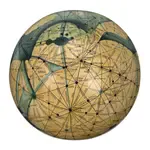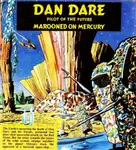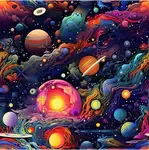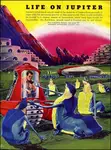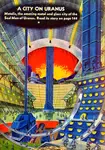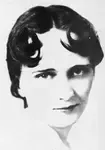Hyperion
The freak among Saturn's moons: an irregular, spongy eccentric that rotates chaotically as it tumbles along its orbit around the Ringed Planet...

Stid: Arrestingly put, Zendexor, but aren't you forgetting something? Hyperion's peculiar shape and rotation weren't known until the Voyager mission, and its spongy nature wasn't known until the Cassini mission. And we're supposed to be ignoring all that modern stuff. We're supposed to be looking at pre-space-age, Old Solar System literature.
Zendexor: Which is rather hard to do, given the awkward fact that I have not been able to discover a single Hyperionian story, or even one that mentions that moon in a CLUFF.
Stid: And you haven't even bothered to write one yourself, as you did with Enceladus and Tethys. Well then, it seems to me that if you insist on doing a page of this kind without the sources to back it up, you're going to have to devote it merely to lamentation... to detailed complaints about what you can't do. And the readers will soon sense you're getting nowhere, and will click off somewhere else.
Zendexor: "Never let a crisis go to waste", as Churchill is supposed to have said. Far from being thwarted by the absence of Hyperionian tales, this page will make use of that lack, allowing us to study how to keep the old torch burning.
Harlei: Good, that's what I was waiting to hear - for it means you're going to supply the lack yourself, aren't you, Z? You'll put yourself into the frame of mind of a pre-space-age author and write...
Stid: I don't believe it can be successfully done. The new, space-probe-revealed Hyperion is just too interesting to forget, and therefore you'll be tempted to keep some of it, the sponginess and the irregular shape, in combination with OSS characteristics such as a breathable atmosphere and native life. The result will seem false, an inappropriate juxtaposition of ideas. Even if it's cleverly done, the modern physical parameters will provide a constant reminder that the tale could not really have been written in the good old days of the OSS. It will therefore form an uneasy hybrid.
Harlei: I don't agree. Your analysis is too limiting. And you won't get Zendexor to agree, considering his own "hybrid" version of the eighth Saturnian moon in The Arc of Iapetus.
Zendexor: Hold it, folks, and allow me to make a couple of points. First, although I don't share his conclusion, in my view Stid is quite right to say that the recent discoveries about Hyperion are "just too interesting to forget". In fact, I'd say they are so striking that they are impossible to forget. Therefore, a new-written story which depicted that moon as a standard spherical body would "stall" insofar as the reader's attention would continually be haunted by the discrepancy with fact. I know you might object that one could say the same about any neo-OSS compositions, but I'd say Hyperion is a special case in that the version revealed by space probes is too outlandish to ignore. My other point -
Stid: Wait a moment. Are you then admitting, what you've denied elsewhere, that the publication date of a story need affect how we read it? That for instance a story about a spherical Hyperion published in, say, 1930 might succeed whereas one published today would not?
Zendexor: Not quite, because if such a story had surfaced in 1930 it would have helped create a tradition which would support a similar effort now.
Stid: I suppose I get that, but still, supposing just one and only one piece of Hyperonian fiction existed and you didn't at first know the date of the story - and you assumed it was 1930's, it being such an enjoyable and convincing pastiche of the old pulps' style - and then, after having thus stealthily advanced underneath your radar, it was revealed to your surprise to be dated 2025... wouldn't you say, aha, this proves that one can get away with a spherical-Hyperion tale even nowadays?
Zendexor: You've got me there. I suppose it could happen. But it's very unlikely to happen. The slightest false step, the slightest wrong note, and the spell would be broken, the illusion would dissolve. Whereas what I wish to propose on this page - and yes, it will be some sort of hybrid - will allow more leeway to the writer. Which brings me to my second point. I suspect - with regard to the spherical versus irregular moon-shape quandary - that it is possible to eat one's cake and have it.
Stid: Sizzling Saturnian stewpots! You mean that Hyperion could be depicted as spherical and non-spherical simultaneously?
Zendexor: You just keep quiet and read on.
the great divide
Imagine, first of all, a scene on a world - let's call it Hulmek. (The reader can soon tell that it's a moon of Saturn, on account of the ringed planet in the sky, but is unable at first to determine which of the nine moons it is.)
Pressure - the huge pressure to conform and not ask deep questions - is a deep and persistent undertone in Hulmekian society. That's one constant theme, one of two dominant ideas, equally characteristic. The other dominant idea is just that - namely, The Other.
That's because two peoples, two interpenetrating nations, share all the lands of Hulmek. And they don't talk to each other; they barely see each other. Each individual is trained to notice only the members of his own nation, unless an acknowledgement of the Other becomes absolutely unavoidable - e.g. on a narrow path or stairway where there's only room for one to pass - in which case a traumatic micro-crisis occurs, involving conflict or desperate evasion.
The plot of the story centres round a scientist, call him Thevo, who has dared to design an Empathy Machine which enables him to see the world through the mind of an Other.
He tries it out. He expects a shock, and gets one. More than one. The shock he half-expected, is the transposition whereby he suddenly sees the "Others" as the Norm whereas his own folk have become the "Others". That makes sense, stunning though the experience is. But more than that, and quite unexpectedly, Thevo finds that Hulmek itself, the world itself, is of different nature and shape to how it previously appeared...
the fusional goal
Stid: I see what you're angling for. Your method of "eating your cake and having it" is to portray two sets of equally strong beliefs about the nature of Hyperion/Hulmek. Each view is absolutely real to the race that has it. But surely, it won't really work. The snag to this dual-vision idea is obvious: not more than one of the versions can be really real. Supposing an outsider, perhaps an Earthman, were to enter the story: what would he see? Whichever form it turned out to be, the verdict would collapse the arrangement of the contradicting views by destroying the parity between them, having shown that only one of the Hyperions is objectively true while the other must be demoted to mere illusion.
Zendexor: You ought to know me better than that, Stid. I shan't be satisfied with a so-called "reconciliation" between Hyperions which ends with one of them being dismissed as no more than a dream. I am determined to preserve the parity between the two versions. True, each contradicts the other when they are considered as a distinct pair. But they become reconcilable when seen as two extreme ends of a continuous spectrum whose gradations provide an ultimate connection between them.
Stid: Huh? "Gradations" - of reality?
Zendexor: Certainly. It's a noble tradition in some advanced sf. Think of Philip K Dick's reality-shimmers in The Game Players of Titan and The Man in the High Castle...
Stid: Oh, is that what you're up to? Alternate realities? Parallel worlds? A glib solution, but I suppose I must allow it.
Zendexor: I'm not putting it that way. For one thing, the two Dick novels mentioned above have a mood of flow, of a shading from one reality to another, rather than any sharp switch between alternates. For another thing, you didn't let me finish. I was about to go on to cite Bayley's The Fall of Chronopolis - now there's a seamless reality-spectrum if ever there was one. And there's the "Net" in Keith Laumer's Worlds of the Imperium series. Yet even these terrific imaginings don't precisely aim at what I'm aiming for in the hypothetical Hyperionian story.
My intended theme is that of a convergence, and an eventual merger, permitted by what you might call the ductility of Hyperion. While its nature is not really divided, not really chopped in two, it does get pulled, stretched...
Stid: By what?
Zendexor: By the stubbornness and determination of its peoples! The power of mind need know no limits -
Stid: Which means that a lazy writer could use it as an excuse for anything -
Zendexor: - and yet the decision to acknowledge this limitless power is in principle scientific, if you regard mind as a product of Nature. Think of the way the super-advanced Fifth Men in Olaf Stapledon's Last and First Men unwittingly alter Earth's gravity through a force that emanates from their cultural complexity. Think of how the traumatised patients in Alfred Bester's Disappearing Act let loose from within themselves an unsuspected capacity for building their own wish-fulfilling worlds. These are science-fiction classics. You can write such stuff, and make it good, provided you take sensible precautions.
Stid: Precautions, yeah, like making sure you are fluent with the blah...
Zendexor: In a way, yes. The great thing is to make sure the theme is not just tacked on, but is made integral to the story.
Harlei: No mere deus ex machina, in other words.
Zendexor: Quite. Make sure you respect the problem, and you'll then find that the answer is to be found in the midst of it. In fact, at the end of the day, the problem is the solution.
Stid: Oh all right, let's accept that the two mutually exclusive, mutually ignoring cultures on Hyperion are pulling their world into two aspects, presumably by some sort of transdimensional elasticity - the question remains, why? What gave rise to this bizarre situation?
the motive that drives the plot
Zendexor: The original reason need not be important in itself. For comparison allow me to cite the antagonisms between Guelfs and Ghibbelines in medieval Italy and Germany, which provided excuses for feuds and hostility long after the original quarrel was forgotten. Still, it would be as well to think of something, just to fill in the picture.
Stid: So - you haven't yet thought of it.
Zendexor: No, but it shouldn't be hard to come up with something. We can just use the basic rule for writing-problems, which, like I said before, is: the problem is the solution. Here goes. Thinking-cap on. Um... Using the technique which detective-story writers doubtless use to plan their works, i.e. "plot it backwards, then write it forwards", we can say that the final cause of the Hyperionian dichotomy is something to do with the "sponginess".
I've read online that the porosity of Hyperion is so high that it's forty per cent empty space. (This has been assumed, I suppose, from the low density.) Well, how's that for sponginess! An amazing, way-out fact, which provides an invitation to any writer with an OSS qualification in excuse-invention to make creative use of it.
How about this:
When life began on Hyperion, one phylum took the form of what I'll call an 'edge-bias', whereby the entities somehow fed not upon matter but upon surfaces - i.e. planes where matter and space meet. (Some blah about density gradients might fit nicely here.) Such life had a preference for rubble rather than solid worlds, due to the need for high surface-area-to-mass ratios. But competing with this life-system was another, a more normal one, which like that of the rest of the Sun's family wanted a home on a compact round world. And so the race was on, to see which arrangement would dominate Hyperion...
Stid: Hey, wait, what about -
Zendexor: No doubt you can think of several objections, but this is an occasion to rely upon Laumer-like hint mode. With the right patter, the right sf mood can be created, one that's good enough to carry forward the story.
where to go from here
Stid: All right, let's assume for purposes of argument that you have laid a sufficient excuse-foundation on which to build a tale which is no more lacking in credibility than most OSS fiction. Let's say you have your stretchable Hyperion which is tugged between its two modes of being by its two races and cultures. The question then arises: how do you propose that this background could be woven into an actual story? I presume the aforesaid background will have to figure strongly - will have to be more than background, in fact.
Zendexor: You presume rightly. The "stretched" nature of Hyperion will have to occupy the focus of the reader's attention. I reckon there must be loads of ways of doing this. Let me suggest one of them and then leave the rest to the readers.
Thevo the Hyperionian, inventor of the Empathy Machine, discovers, as mentioned above, the "spongy" and irregular nature of his world as seen by the Other Race. For a long time he remains in hiding, unable to bear the truth, and filled with continuing hatred for the Others despite his new empathy with their mode of perception.
Then comes an invasion. Beings from some weird planet - perhaps Earth - try to occupy Hyperion. Thevo's people by themselves are not strong enough to repulse them. But it occurs to Thevo that if his people and the Others were to co-operate, the combination might make itself felt against the invaders.
Co-operation ensues, and as a result the world of Hyperion is strengthened in its uniqueness... but there's an ironic coda: since the Others had made the greatest contribution to the fight (spongy cavern-filled territory being the most suited to guerilla warfare) the version of the little world which gains most kudos is that irregular spongy one, the primacy of which is confirmed by the astronomy of the defeated Terrans.









